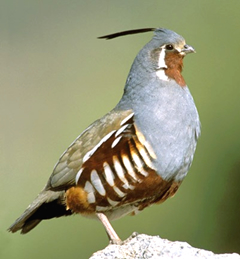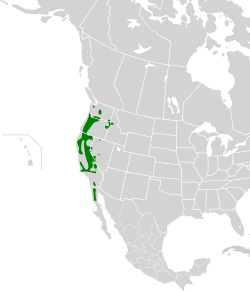From Wikipedia
Open on WikipediaThis article has an unclear citation style. (March 2023) |
| Mountain quail | |
|---|---|

| |
| Male | |
| Scientific classification | |
| Kingdom: | Animalia |
| Phylum: | Chordata |
| Class: | Aves |
| Order: | Galliformes |
| Family: | Odontophoridae |
| Genus: | Oreortyx Baird, 1858 |
| Species: | O. pictus
|
| Binomial name | |
| Oreortyx pictus (Douglas, 1829)
| |

| |
The mountain quail (Oreortyx pictus) is a small ground-dwelling bird in the New World quail family. This species is the only one in the genus Oreortyx, which is sometimes included in Callipepla. This is not appropriate, however, as the mountain quail's ancestors diverged from other New World quails earlier than the bobwhites, no later than 6 mya.[2]
Description
[edit]The bird's average length is 26–28 cm (10–11 in), with a wingspan of 35–40 cm (14–16 in). They have relatively short, rounded wings and long, featherless legs. These birds are easily recognized by their topknots, which are shorter in the female and change color with the seasons and geographic location of particular populations. They have a brown face, gray breast, brown back and primaries, and heavily white barred underside. Females display greater brown coloring on their dorsal side, a paler red on their undersides, and wider white barring on the flank than their male counterparts. Mountain quails lose the multi-color primary coverts on their wings as they age, and by 15 months old will only have solid-colored coverts.

Subspecies
[edit]There are five recognized subspecies:[3]
| Image | Subspecies | Distribution |
|---|---|---|
| O. p. pictus – (Douglas, 1829) | nominate, found in the Cascade Range of Washington to coastal mountains of central California | |
 |
O. p. plumifer – (Gould, 1837) | Southern Washington to western Nevada and central California |
 |
O. p. russelli – AH Miller, 1946: pallid mountain quail | Little San Bernardino Mountains of southern California |
| O. p. eremophilus – van Rossem, 1937: desert mountain quail | Sierra Nevada of southern California to northern Baja, and extreme southwestern Nevada | |
| O. p. confinis – Anthony, 1889: southern mountain quail | mountains of northern Baja California |
Distribution and habitat
[edit]It inhabits mountainous chaparral west of the Rocky Mountains, from British Columbia in Canada, and some areas of Washington state in the United States, to Baja Peninsula, Mexico. It can be found up to 3,000 m (9,800 ft) above sea level. It is a non-migratory species; however some populations may be altitudinal migrants in some mountain ranges. Mountain quails also inhabit lava reefs in the Modoc Plateau of California, in addition to the chaparral and wooded areas of the Sierra Nevada Mountains and Coast Range.
Behavior
[edit]Mountain quail primarily move about by walking, and can move surprisingly quickly through brush and undergrowth. In the late summer, fall and winter, the adults and immature young congregate into family groups of up to 20 birds. The birds' habits can be secretive. Any flight is usually short and explosive, with many rapid wingbeats followed by a slow glide to the ground.
Feeding
[edit]Its diet consists primarily of plant matter and seeds. The chicks are decidedly more insectivorous than adults, gradually consuming more plant matter as they mature.
Breeding
[edit]
Breeding among mountain quail is monogamous and rarely gregarious. The female typically lays 9–10 eggs in a simple scrape concealed in vegetation, often at the base of a tree or shrub, usually close to water. Incubation lasts from 21 to 25 days, usually performed by the female and rarely by the male. However, preliminary research by the University of Nevada suggests that males have successfully incubated chicks on their own, which creates the possibility of a pair of mountain quails raising two broods in one breeding season.[4] The chicks are precocial, leaving the nest with their parents within hours of hatching.
Status and conservation
[edit]It is not considered threatened by the IUCN, being plentiful across a wide range. However, its success is tied to sufficient habitat, which expands in cooler and more arid climate. Subfossil remains have been found, for example at Rocky Arroyo in the Guadalupe Mountains and Shelter Cave, New Mexico, where sufficient habitat no longer exists. The bones date found from the end of the last ice age to not much more than 8000 BC.[5] A petition to list the mountain quail as endangered or threatened was denied by the U.S. Fish and Wildlife Service in 2003. However, outside of California, the birds' habitat has been decreasing in Idaho, Nevada, and eastern Oregon and Washington because of drought and human activity, including agriculture and development.
References
[edit]- ^ BirdLife International (2021). "Oreortyx pictus". IUCN Red List of Threatened Species. 2021: e.T22679591A139204160. doi:10.2305/IUCN.UK.2021-3.RLTS.T22679591A139204160.en. Retrieved 12 November 2021.
- ^ Zink, Robert M.; Blackwell, Rachelle C. (1998). "Molecular systematics of the Scaled Quail complex (genus Callipepla)". Auk. 115 (2): 394–403. doi:10.2307/4089198. JSTOR 4089198.
- ^ Gill, F.; Donsker, D., eds. (2014). "IOC World Bird List" (v 4.4 ed.). doi:10.14344/IOC.ML.4.4. Retrieved 31 October 2014.
- ^ Delehanty, David (October 23, 1994). "Incubation and Brood Rearing by a Wild Mountain Quail" (PDF). sora.unm.edu. Retrieved June 29, 2023.
- ^ Howard, H.; Miller, A.H. (1933). "Bird remains from cave deposits in New Mexico". Condor. 35 (1): 15–18. doi:10.2307/1363460. JSTOR 1363460.
- Carroll, John P. (1994). "4. Mountain Quail". In del Hoyo, Josep; Elliott, Andrew; Sargatal, Jordi (eds.). Handbook of Birds of the World. Vol. 2: New World Vultures to Guineafowl. Barcelona, ES: Lynx Edicions. p 423, plate 39. ISBN 84-87334-15-6. see article Handbook of Birds of the World
- Field Guide to the Birds of North America. Washington, DC: National Geographic Society. 2002. ISBN 0-7922-6877-6.
- Sibley, David Allen (2000). The Sibley Guide to Birds. New York, NY: Knopf. ISBN 0-679-45122-6.
External links
[edit]- "Mountain quail media". Internet Bird Collection.
- Mountain quail photo gallery at VIREO (Drexel University)
- Mountain quail Species Account – Cornell Lab of Ornithology
- Educational Quails Worksheet for Kids on EasyScienceforKids
- BirdLife species factsheet for Oreortyx pictus
- Interactive range map of Oreortyx pictus at IUCN Red List
- Audio recordings of Mountain quail on Xeno-canto.
- ^ Brennan, Leonard; Block, William; Gutiérrez, R. J. (1987). ""Habitat Use by Mountain Quail in Northern California"" (PDF). The Condor. 89 (89): 66–74. doi:10.2307/1368760. JSTOR 1368760. S2CID 87805494 – via UNM SORA.
- ^ Delehanty, David (1995). "Incubation and Brood Rearing by a Wild Male Mountain Quail" (PDF). Western Birds (26): 46–48 – via UNM SORA.
- ^ Van Rossem, A. J. (1937). "A Review of the Races of the Mountain Quail" (PDF). The Condor. 39 (1): 20–24. doi:10.2307/1363484. JSTOR 1363484 – via UNM SORA.
- ^ Delehanty, David; Turek, Nichole (2003). "Using Wing Plumage to Determine Age of Mountain Quail" (PDF). North American Bird Bander. 28 (3): 116–120 – via UNM SORA.
- ^ January 16, 1995 Mountain Quail Status Report by Christine A. Vogel and Kerry Reese for Eastside Ecosystem Management Project https://www.fs.usda.gov/r6/icbemp/science/vogel.pdf
- ^ "Federal Register :: Request Access". unblock.federalregister.gov. Retrieved 2022-10-17.
About
No page comments added.Synonyms
- MOUQ




